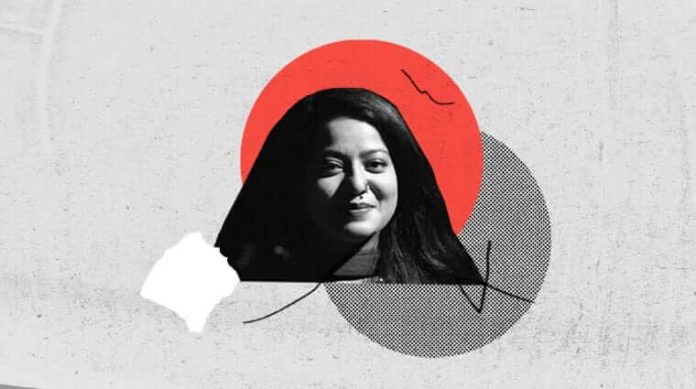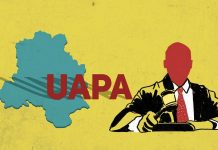This article is written by Anisha Bhandari, pursuing B.A. LLB (Hons.) from Institute of Law, Nirma University.
Table of Contents
Introduction
The 27-year old sociologist at the renowned Jamia Millia Islamia University had been married 19 months earlier, and Mrs Zargar had just learned that she was pregnant. She suffered from fatigue and usually felt lethargic. The officers told them they were from the “Special Cell”—the anti-terror branch of the Delhi Police — and requested her to travel with them to their office in central Delhi. They said they wanted to ask her several questions regarding her role in demonstrations against the divisive bill on citizenship, which opponents claim is biased against Muslims. For several hours, Mrs Zargar was questioned at the police station, and at 22:30 she was arrested. It was Friday, April 10th.
So she’s been in Delhi’s overcrowded Tihar prison for a month now at a time when India is under a tight lockdown to fight the coronavirus pandemic, and the government’s own advisory says pregnant women are particularly vulnerable to infection. Ms Zargar was convicted under the Unlawful Activities Prevention Act (UAPA)-a punitive statute that renders it virtually difficult for the accused to seek bail. Since her arrest, she has been allowed to make two five-minute phone calls to her husband and her lawyer. Both visits and letters were denied on the grounds of the Covid-19 restrictions. Ms Zargar is one of a number of Muslim students and activists who have been jailed since the Indian lock-up began on 25 March, on charges that the government is using the pandemic to crackdown on freedom of speech and dissension.
As a member of the Jamia Coordination Committee (JCC), a student group, she has been active in organizing peaceful protests against the CAA in North East Delhi. Her sister Sameeya describes her as “very clumsy, unpopularly honest, and very thoughtful.”
Background of the case
The CAA was introduced by the Indian Parliament on 12 December 2019 and approved by the President of India. The CAA offers a route to Indian citizenship for Hindus, Sikhs, Persians, Christians, Buddhists, and Jains from Afghanistan, Bangladesh, and Pakistan, barring Muslims, thereby legitimizing discrimination dependent on religious grounds.
The United Nations High Commissioner for Human Rights, the European Parliament, the United States Commission on International Religious Freedom (USCIRF), and some US senators have posed significant questions regarding the CAA.
The amendments to the Citizenship Act also arm the National Registry of Citizenship (NRC), the National Population Register (NPR), and the Foreigners Tribunals to force minorities – particularly Muslims – into detention and statelessness. As of now, more than 1.9 million citizens have been removed from the NRC, a registration process that has been carried out in Assam State for a duration of five years. Protests against CAA amendments have been taking place across India since December 2019. On 12 December, Akhil Gogoi, activist and chief of Krishak Mukti Sangram Samiti (KMSS), a peasant rights group based in Assam, was arrested by the Assam Police under different sections of the UAPA. KMSS has been instrumental in organizing anti-CAA protests across Assam. He was given bail on 26 March 2020.
In December 2019, in Varanasi, the electoral district of Prime Minister Narendra Modi, the police indiscriminately used firearms and less-lethal weapons to disperse peaceful protesters. This culminated in the death of an eight-year-old boy who was crushed to death on 20 December 2019, resulting in more than a dozen casualties. Police have targeted student demonstrators at Jamia Millia Islamia University and Jawaharlal Nehru University (JNU) in Delhi in December 2019 and January 2020 respectively. Students were also targeted at Aligarh Muslim University (AMU) while demonstrating against the CAA in December 2019. To date, though, no complaints have been lodged against police officers over the use of unnecessary force against demonstrators. On 22 February, a number of unarmed demonstrators seized a stretch of the road near Jafrabad Metro Station in the north-eastern portion of New Delhi. They were demonstrating against the NRC and the CAA.
On 2 April, the Delhi Police detained Meeran Haider, a PhD student at the University of Jamia Millia Islamia and publicity advisor for the Jamia Coordination Committee. Days later, Safoora Zargar, an MPhil student at the same university, was detained for reportedly blocking the path outside Jafrabad Metro Station. Both remain in custody while awaiting further investigation. Both the girls, Meeran Haider and Safoora Zargar, have also been charged with sedition, murder, attempted murder, raising enmity between various classes on grounds of ethnicity, and rioting.
The ambit of fundamental rights
It is much more severe than the violation of Article 21, which preserves life and liberty. It teaches us about the state’s technology of law, which pressures its armed Hindu citizen foot-soldiers, its media allies, its armed police, and its collusive criminal justice system to keep Zargar in jail in the awareness that she is pregnant, while the argument against her is obviously one that is motivated and a show of administrative vindictiveness. It tells us about the power of the resistance of Zargar and the lack of urgency for the constitutional courts to intervene on her behalf in the name of the Constitution. The integrity of the constitutional courts is undermined by their overt deference to indefensible state intervention.
The Unlawful Activities (Prevention) Act, 1967, in which Zargar was detained, as other anti-terror laws in India, is focused on the assumption of state immunity and criminalizes any resistance to unconstitutional intervention by the state. There are two distinct categories of offences: “unlawful activity” and “terrorist activity.” Between 2008 and 2013, reforms were adopted to show transparency in the application of universal norms of combatting terrorism. Section 2(o) of the Act describes “unlawful activity” as any action taken by any person or entity (whether by an act or through language, spoken or written, or by signs or by obvious representation or otherwise) – (ii) which disclaims, asks, disrupts or is intended to disrupt the sovereignty and territorial integrity of India; or (iii) which causes or is intended to cause harm to the sovereignty and territorial integrity of India; CHAPTER IV-VI (Sections 15-40) of the Act focuses on terrorist crimes and organizations.
Arguments put forth
The prosecution’s argument at Zargar’s bail hearing in Delhi’s Patiala House Court on 4 June is, and the judge admitted, that “[t]he conduct which threatens to establish a chaos or disruption of law and order to the point where the entire city is brought to its knees and the entire government machinery is brought to a halt will obviously be viewed as unlawful. Seeking bail under Section 439 of the CrPC, Zargar’s counsel argued that the Delhi Police was creating a false narrative involving innocent students who did not approve of the government’s policies, specifically the Citizenship Amendment Act. The council stated that Zargar had visited Chand Bagh for a short period of time on 23 February, but that there were no incidents of violence that day. Furthermore, her statement was not provocative, and she did not encourage anybody to respond to abuse.
Analysis of the court’s ruling
Without any judicial deliberation or reference to the evidence, information and contradictions reported before it, the court was swift to place criminal liability on a Muslim woman in this case for mass violence and immeasurable damage to life and properties, as well as the incitement to violence in North East Delhi at the end of February against Muslims. This is given the fact that Justice S. Muralidhar of the Delhi High Court on 26 February directed FIRs to be reported against Bharatiya Janata Party members after documenting their inflammatory hate speech in the courtroom before the riots. This needs to be understood and discussed publicly. It is a matter of personal liberty. We reside in an age in which the concept of non-retrogression of civil rights – indeed constitutional morality – has been upheld by the Supreme Court, and the right to a free hearing and complete protection of the right to life and personal liberty has been considered a lie at the root of the definition of human integrity.
Minorities in the Constituent Assembly, of course, applied to ethnic minorities, scheduled castes and scheduled tribes – and what Ambedkar proposed was a collective minority vote on the dominant member in each electoral district (immediately after Partition). His was the lone voice (as was always the case) – and this is prescient, worth recalling, particularly in the context of the questions that Zargar was bringing before us and the occurrences that foretold her imprisonment.
When Safoora Zargar protests against the Islamophobe, Hindu regime that passed the Citizenship Amendment Act, she fights to protect India’s soul. She achieved so, not through firearms and inflammable chemicals and weapons of death and terror, but by nonviolent protests. Not by provocative remarks that encourage widespread abuse, but with a particular emphasis on the abolition of unethical, counter-constitutional legislation. So she is demonstrating alongside hundreds of thousands of people. This is our inheritance, too. Ethical dissidence and civil disobedience. The court ruling that a nonviolent demonstration by Muslims against a law that deliberately excludes them and imposes a system of citizenship – in breach of any constitutional right in the Constitution – is an invitation to state and majority aggression is unjustified.
Chapters IV (‘Punishment of Terrorist Activities’) and VI (‘Terrorist Organizations’) lays out criteria for the prosecution of individuals convicted of crimes. Pursuant to Section 43(D)(5), the refusal to grant bail must be focused (as it should be) on the opinion of the court that there are fair grounds to assume that the claim against that individual is prima facie valid. Judiciary independence, which is crucial in the matter of personal liberties, is misread by the court as a ‘statutory ban’ in the classic illustration of ‘judiciary pusillanimity’ – a phrase used by late Justice Leila Seth and quoted with approval by the Supreme Court in Navtej Johar’s judgment in 2018. The most significant flaw of this judgment is that, in colluding with the prosecution’s case and denying bail pursuant to Section 43(D)(5), the court mixed “unlawful conduct” with “terrorist activity.” And the prosecution’s sole reference was to “unlawful conduct.” There is a manifestly discriminatory application of Section 43(D)(5) of supposedly “unlawful” conduct (not “terrorist activity”) culminating in unfair prosecution even prior to court. Finally, disaffection against the government is defined by the court as disaffection against India under the Act on unlawful activities (Prevention).
Conclusion
The court decided that it did not argue with the indictment that “the accused parties had conspired to trigger a disruption of such nature and severity that it would contribute to chaos and interruption of law and order on an unparalleled scale.” The order does not include any information. When the accusation of a plot was denied by the defence on the basis that Zargar was not physically present at the incident, the court went a little further and rendered the argument clear that, because there was prima facie proof of a plot, it should be admissible against everyone, including those not physically present. When her frail health status was revealed to the judge, the court merely ordered the “concerned prison director” to have appropriate medical care despite her fragile medical situation.
Bail was rejected for the third time because, in the words of the experienced judge, as you want to play with the embers, you can not fault the wind for taking the flame a bit too far and spreading the flames. The court claimed that it was “not concerned with the sanctity of the information available on record, yet in the light of the material available on record, it can not be argued that there is no prima facie case brought against the applicant / accused”.
However, although the case brought by the prosecution pertains to subsection 2(o) of the Act on Unlawful activities (Prevention) and 2(p) of the Act on Unlawful assembly, the court limited its own limits by citing “the statutory ban” under the provisions of section 43(D)(5) [which] is appealed in the present case.
LawSikho has created a telegram group for exchanging legal knowledge, referrals and various opportunities. You can click on this link and join:
 Serato DJ Crack 2025Serato DJ PRO Crack
Serato DJ Crack 2025Serato DJ PRO Crack











 Allow notifications
Allow notifications



